Page 303 of 319
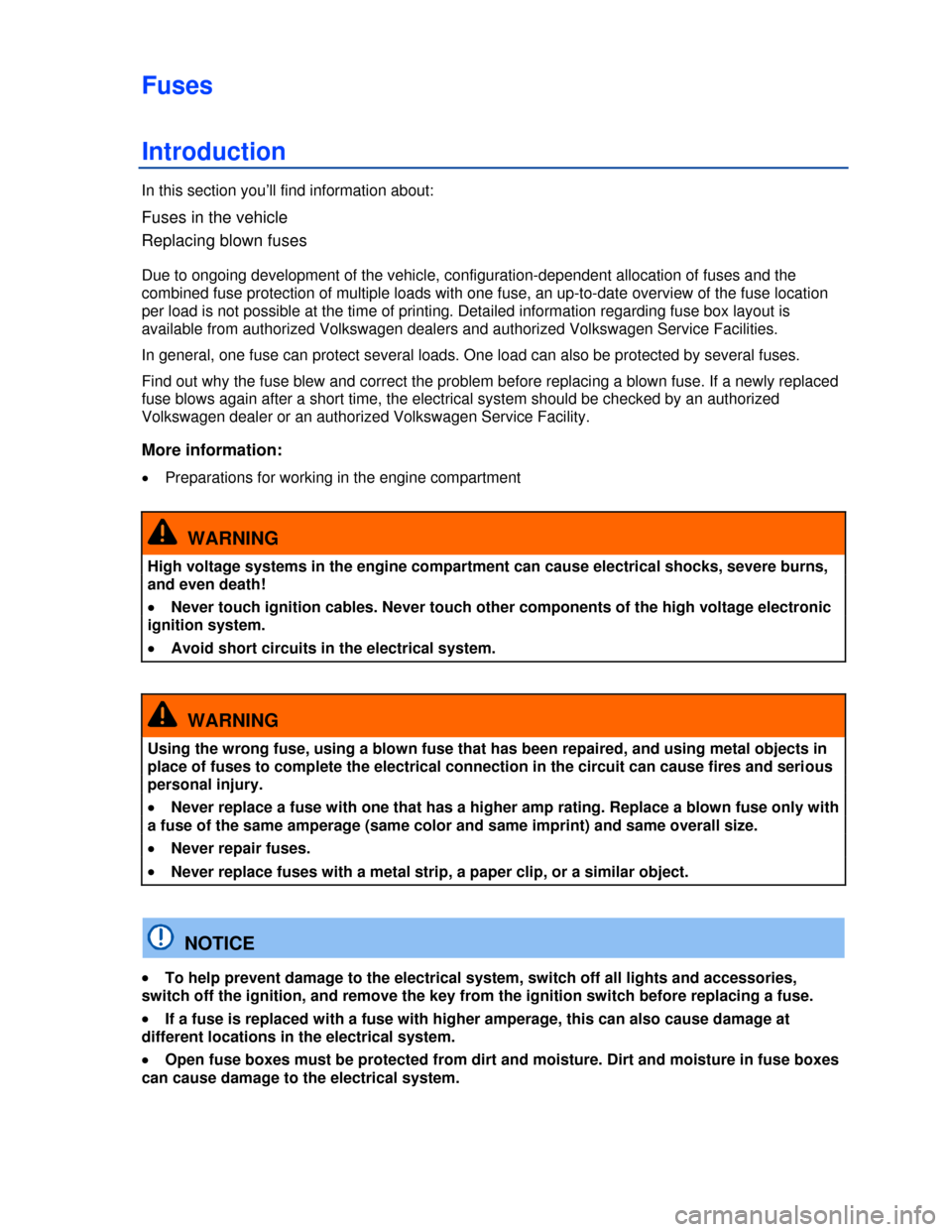
Fuses
Introduction
In this section you’ll find information about:
Fuses in the vehicle
Replacing blown fuses
Due to ongoing development of the vehicle, configuration-dependent allocation of fuses and the
combined fuse protection of multiple loads with one fuse, an up-to-date overview of the fuse location
per load is not possible at the time of printing. Detailed information regarding fuse box layout is
available from authorized Volkswagen dealers and authorized Volkswagen Service Facilities.
In general, one fuse can protect several loads. One load can also be protected by several fuses.
Find out why the fuse blew and correct the problem before replacing a blown fuse. If a newly replaced
fuse blows again after a short time, the electrical system should be checked by an authorized
Volkswagen dealer or an authorized Volkswagen Service Facility.
More information:
�x Preparations for working in the engine compartment
WARNING
High voltage systems in the engine compartment can cause electrical shocks, severe burns,
and even death!
�x Never touch ignition cables. Never touch other components of the high voltage electronic
ignition system.
�x Avoid short circuits in the electrical system.
WARNING
Using the wrong fuse, using a blown fuse that has been repaired, and using metal objects in
place of fuses to complete the electrical connection in the circuit can cause fires and serious
personal injury.
�x Never replace a fuse with one that has a higher amp rating. Replace a blown fuse only with
a fuse of the same amperage (same color and same imprint) and same overall size.
�x Never repair fuses.
�x Never replace fuses with a metal strip, a paper clip, or a similar object.
NOTICE
�x To help prevent damage to the electrical system, switch off all lights and accessories,
switch off the ignition, and remove the key from the ignition switch before replacing a fuse.
�x If a fuse is replaced with a fuse with higher amperage, this can also cause damage at
different locations in the electrical system.
�x Open fuse boxes must be protected from dirt and moisture. Dirt and moisture in fuse boxes
can cause damage to the electrical system.
Page 306 of 319
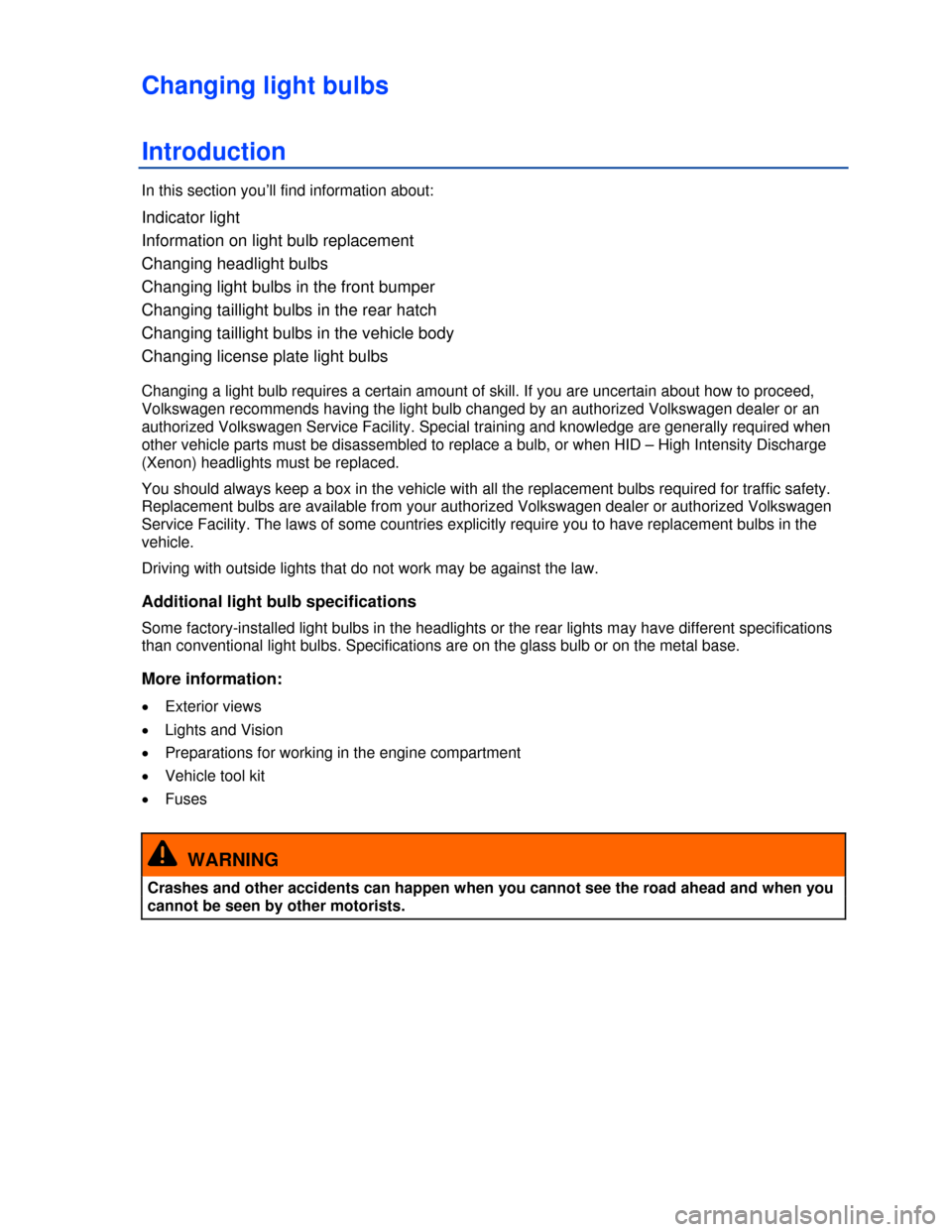
Changing light bulbs
Introduction
In this section you’ll find information about:
Indicator light
Information on light bulb replacement
Changing headlight bulbs
Changing light bulbs in the front bumper
Changing taillight bulbs in the rear hatch
Changing taillight bulbs in the vehicle body
Changing license plate light bulbs
Changing a light bulb requires a certain amount of skill. If you are uncertain about how to proceed,
Volkswagen recommends having the light bulb changed by an authorized Volkswagen dealer or an
authorized Volkswagen Service Facility. Special training and knowledge are generally required when
other vehicle parts must be disassembled to replace a bulb, or when HID – High Intensity Discharge
(Xenon) headlights must be replaced.
You should always keep a box in the vehicle with all the replacement bulbs required for traffic safety.
Replacement bulbs are available from your authorized Volkswagen dealer or authorized Volkswagen
Service Facility. The laws of some countries explicitly require you to have replacement bulbs in the
vehicle.
Driving with outside lights that do not work may be against the law.
Additional light bulb specifications
Some factory-installed light bulbs in the headlights or the rear lights may have different specifications
than conventional light bulbs. Specifications are on the glass bulb or on the metal base.
More information:
�x Exterior views
�x Lights and Vision
�x Preparations for working in the engine compartment
�x Vehicle tool kit
�x Fuses
WARNING
Crashes and other accidents can happen when you cannot see the road ahead and when you
cannot be seen by other motorists.
Page 307 of 319
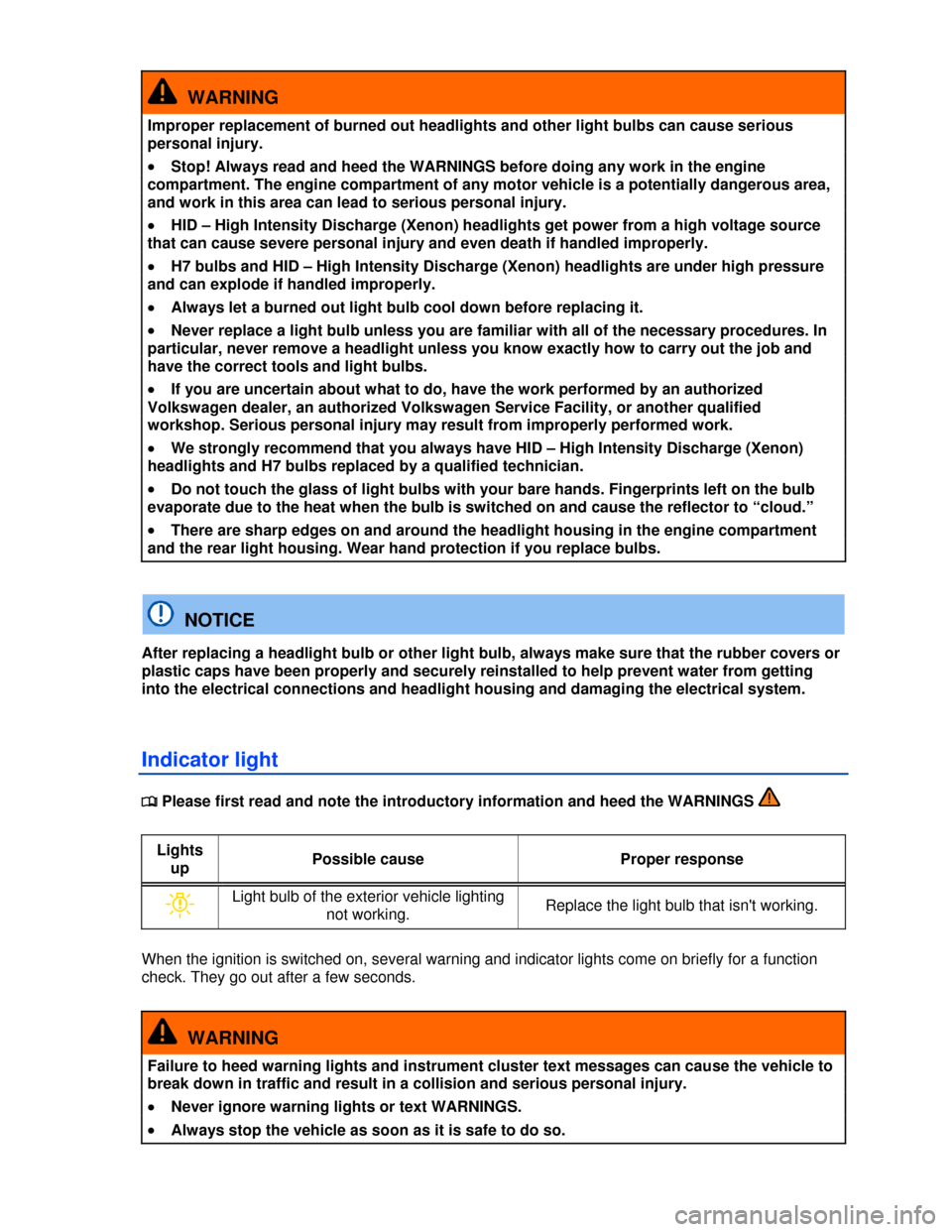
WARNING
Improper replacement of burned out headlights and other light bulbs can cause serious
personal injury.
�x Stop! Always read and heed the WARNINGS before doing any work in the engine
compartment. The engine compartment of any motor vehicle is a potentially dangerous area,
and work in this area can lead to serious personal injury.
�x HID – High Intensity Discharge (Xenon) headlights get power from a high voltage source
that can cause severe personal injury and even death if handled improperly.
�x H7 bulbs and HID – High Intensity Discharge (Xenon) headlights are under high pressure
and can explode if handled improperly.
�x Always let a burned out light bulb cool down before replacing it.
�x Never replace a light bulb unless you are familiar with all of the necessary procedures. In
particular, never remove a headlight unless you know exactly how to carry out the job and
have the correct tools and light bulbs.
�x If you are uncertain about what to do, have the work performed by an authorized
Volkswagen dealer, an authorized Volkswagen Service Facility, or another qualified
workshop. Serious personal injury may result from improperly performed work.
�x We strongly recommend that you always have HID – High Intensity Discharge (Xenon)
headlights and H7 bulbs replaced by a qualified technician.
�x Do not touch the glass of light bulbs with your bare hands. Fingerprints left on the bulb
evaporate due to the heat when the bulb is switched on and cause the reflector to “cloud.”
�x There are sharp edges on and around the headlight housing in the engine compartment
and the rear light housing. Wear hand protection if you replace bulbs.
NOTICE
After replacing a headlight bulb or other light bulb, always make sure that the rubber covers or
plastic caps have been properly and securely reinstalled to help prevent water from getting
into the electrical connections and headlight housing and damaging the electrical system.
Indicator light
�
Page 310 of 319
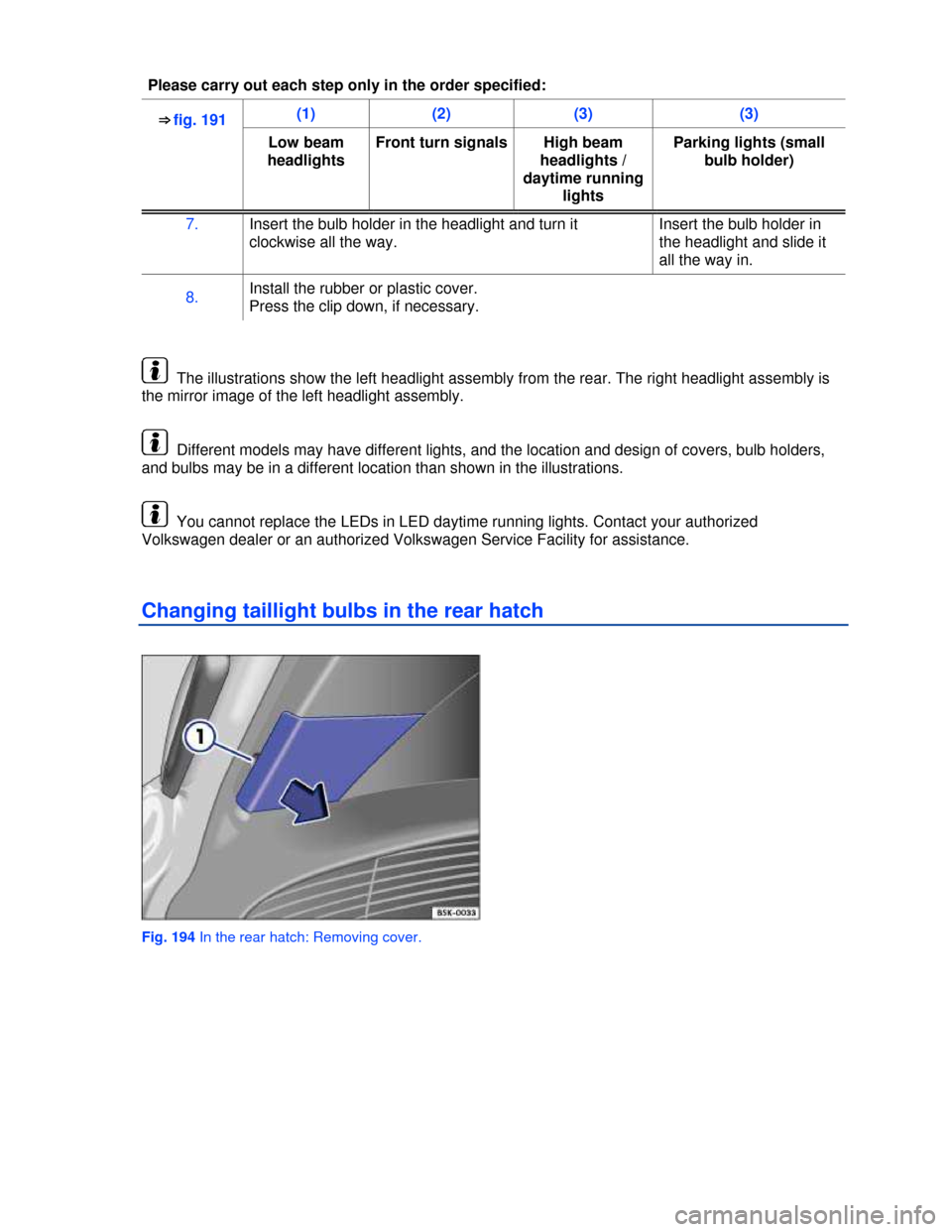
Please carry out each step only in the order specified:
⇒ fig. 191 (1) (2) (3) (3)
Low beam
headlights
Front turn signals High beam
headlights /
daytime running
lights
Parking lights (small
bulb holder)
7. Insert the bulb holder in the headlight and turn it
clockwise all the way.
Insert the bulb holder in
the headlight and slide it
all the way in.
8. Install the rubber or plastic cover.
Press the clip down, if necessary.
The illustrations show the left headlight assembly from the rear. The right headlight assembly is
the mirror image of the left headlight assembly.
Different models may have different lights, and the location and design of covers, bulb holders,
and bulbs may be in a different location than shown in the illustrations.
You cannot replace the LEDs in LED daytime running lights. Contact your authorized
Volkswagen dealer or an authorized Volkswagen Service Facility for assistance.
Changing taillight bulbs in the rear hatch
Fig. 194 In the rear hatch: Removing cover.
Page 316 of 319
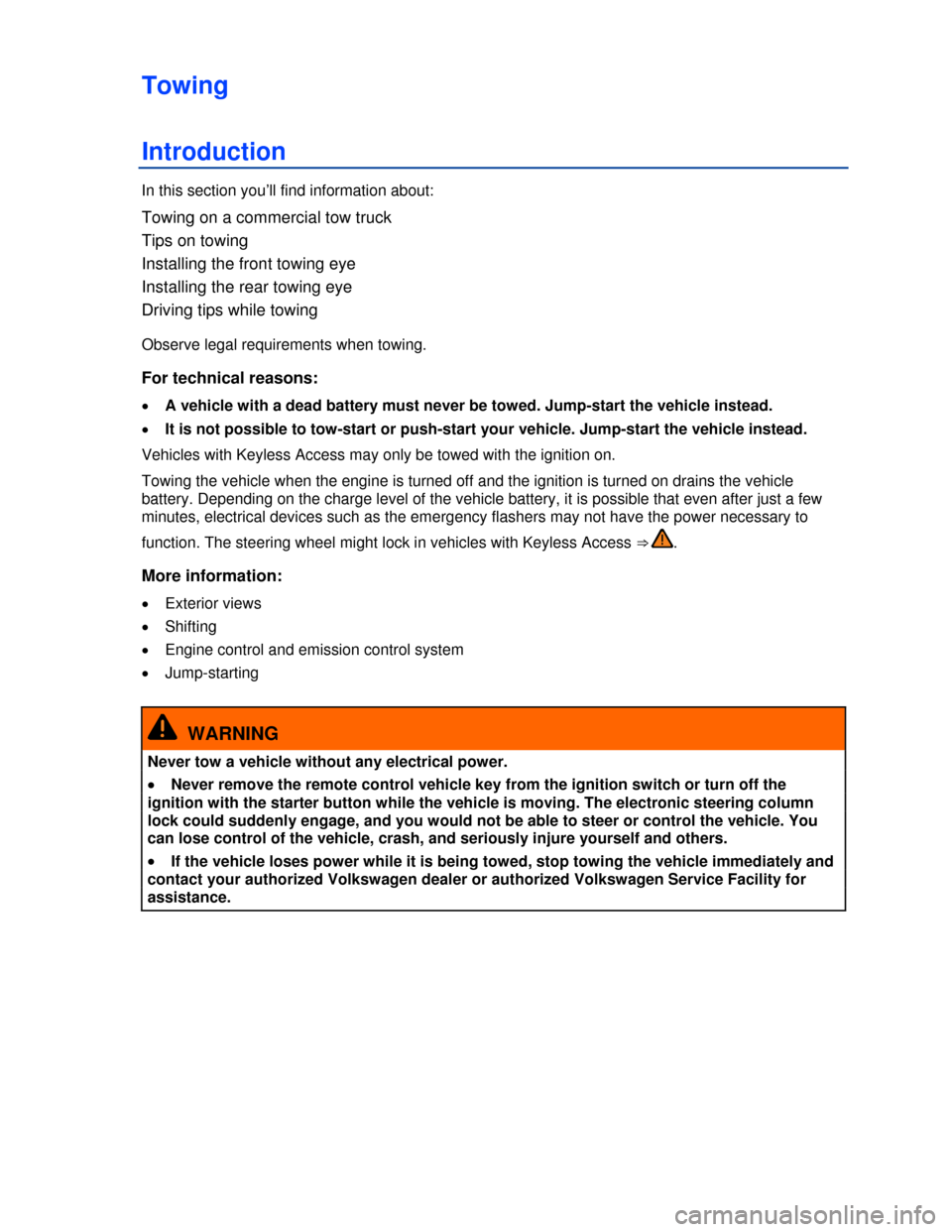
Towing
Introduction
In this section you’ll find information about:
Towing on a commercial tow truck
Tips on towing
Installing the front towing eye
Installing the rear towing eye
Driving tips while towing
Observe legal requirements when towing.
For technical reasons:
�x A vehicle with a dead battery must never be towed. Jump-start the vehicle instead.
�x It is not possible to tow-start or push-start your vehicle. Jump-start the vehicle instead.
Vehicles with Keyless Access may only be towed with the ignition on.
Towing the vehicle when the engine is turned off and the ignition is turned on drains the vehicle
battery. Depending on the charge level of the vehicle battery, it is possible that even after just a few
minutes, electrical devices such as the emergency flashers may not have the power necessary to
function. The steering wheel might lock in vehicles with Keyless Access ⇒ .
More information:
�x Exterior views
�x Shifting
�x Engine control and emission control system
�x Jump-starting
WARNING
Never tow a vehicle without any electrical power.
�x Never remove the remote control vehicle key from the ignition switch or turn off the
ignition with the starter button while the vehicle is moving. The electronic steering column
lock could suddenly engage, and you would not be able to steer or control the vehicle. You
can lose control of the vehicle, crash, and seriously injure yourself and others.
�x If the vehicle loses power while it is being towed, stop towing the vehicle immediately and
contact your authorized Volkswagen dealer or authorized Volkswagen Service Facility for
assistance.